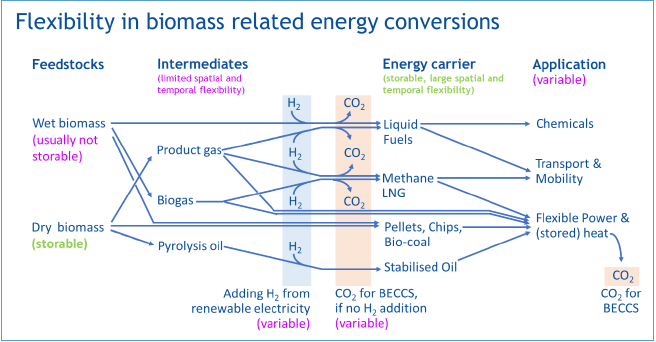Technologies for Flexible Bioenergy
The increasing share of renewable energy sources such as photovoltaic systems and wind turbines, of which electricity production depends on weather conditions, leads to a need for more flexibility and controllability of other energy sources, energy carriers and energy storage devices. Flexibility can be defined from different perspectives, such as from system, process or component level perspective. Bioenergy and system integration cover multiple dimensions of flexibility, including temporal and spatial flexibility, as well as flexibility with respect to feedstock, operation, and end-products.
This report, produced by IEA Bioenergy Task 44 (Flexible Bioenergy and System Integration), highlights a number of technologies which make the inherent flexibility of sustainable bioenergy usable. A concise overview of the technical possibilities is presented in the base report; in the appendix more detailed information on individual flexible bioenergy technologies including references is given.
The flexibility of bioenergy has several dimensions:
- Short term flexibility to balance and stabilize the electricity grid by both positive and negative ancillary services
- Long term flexibility by biomass-based energy carriers that can be (seasonally) stored and transported within existing infrastructure
By far not all of the technically possible and successfully demonstrated process options are regularly applied. While burning biomass or biomass based intermediates and energy carriers for production of heat or combined heat and power is quite common, the flexibility of these units for positive ancillary services (adapt production depending on demand) is only rarely exploited; mostly in countries where suited incentives such as a flexibility premium exist.
Negative ancillary service, i.e. the flexible up-take of electricity that cannot be used otherwise at time and site of its production by e.g. Power-to-Gas or Power-to-Liquid type processes, is technically solved and was successfully demonstrated only for biogas-upgrading by methanation of the CO2 content. Flexible hydrogen addition to wood gasification gas or within hydrothermal gasification or liquefaction is still under development.
Long term flexibility, i.e. the conversion of biomass to energy carriers that can be easily transported or stored within existing infrastructure, is quite common for liquid biofuels or for biogas upgrading to grid-compatible biomethane by CO2 separation. The conversion of wood to non-solid energy carriers such as methane, stabilized pyrolysis oil, Fischer-Tropsch Diesel or similar has been demonstrated, but still needs to take further steps for good business cases.
As a common observation, the flexible processes that are successful in most countries are starting from waste streams that have to be treated but cannot easily be valorized otherwise, e.g. sewage sludge to biogas to biomethane. The flexible use of woody feedstock is so far limited from two sides: on the one hand, simple combustion to cover heat needs is a financially more attractive alternative to more complex conversion processes, as long as there is sufficient heat demand. On the other hand, due to the value of energy wood and the more complex processes, energy carriers based on wood have a higher price difference to fossil energy carriers than those starting from biogas from waste inputs.
With the further increasing share of variable renewables like PV and wind in the energy system, the flexibility of bioenergy, i.e. positive and negative ancillary services for the electricity grid and options for storage and transport within existing infrastructure, will become more and more important, but will depend on a suitable market design and for some period also support schemes to anticipate for upcoming higher flexibility needs in the energy system and to allow the stakeholders to decide for the better investments.



